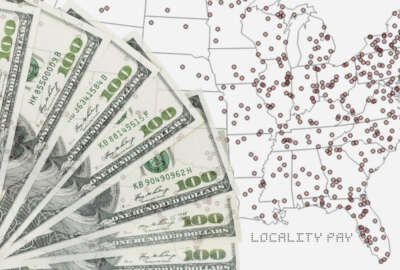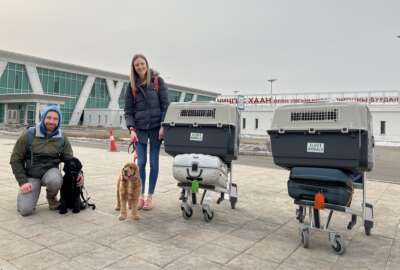Guess what? It’s not too late to help out the Combined Federal Campaign.
Just because the Christmas season is in the rear-view mirror, doesn't mean you can't still give. In fact, the Combined Federal Campaign (CFC) continues until...
Just because the Christmas season is in the rear-view mirror, doesn’t mean you can’t still give. In fact, the Combined Federal Campaign (CFC) continues until January 15. For a summary of the most recent campaign, the Federal Drive with Tom Temin spoke with the chair of the CFC for the National Capital Region, Vince Micone.
Interview Transcript:
Tom Temin And how has the campaign gone this year? What were your goals and where are we at this point? With still a week and a half to go?
Vince Micone Well, we’re in strong shape right now across the nation. $52 million has been raised by federal employees here in the D.C. area in the DMV. We’ve raised over 26 million. That’s half of the national total in the last two weeks. The last two weeks of the campaign are very important to us. They’re actually $5 million weeks. By the 15th, we hope to get about $10 million more support causes and charities in the region, around the country and across the globe.
Tom Temin Because federal employees will have had an average of 4 to 5% pay raise. I wonder if that’ll help boost the giving in the 2024 period for the 23 campaign.
Vince Micone Well, you know, I think getting that gift from Uncle Sam means maybe we ought to give a little bit of a gift back to the community. You know, the average gift in the DMV from federal employees is just over $1,000 in CFC contributions, whether people give one time through payroll deduction or if they pledge volunteer hours, it’s a pretty significant amount that federal employees contribute annually.
Tom Temin And what is the most common mode of giving? How do people normally give a payroll deduction of cash and they pick a charity? Or what’s the mode here?
Vince Micone The most common way that federal employees give us through payroll deduction, where a little bits taken out of every paycheck, whether it’s biweekly or twice a month or monthly pay. And so folks may contribute ten, 15, 25, $100 a pay period. They can pick one charity, multiple charities. There’s a lot of flexibility in the campaign, which is what makes it so popular.
Tom Temin And maybe just review the roster of charities this year. Some of them come and go, but there’s some eternals on that list and it’s a big list, isn’t it?
Vince Micone We have 5000 charities right now in the campaign. And one thing all the listeners should know is that every year all of these charity partners are reviewed by federal employees to make sure that they’re legitimate 501c3 nonprofits. That they have audits if required and that they follow good practices. So there are legitimate charities in the campaign.
Tom Temin Are there any that stand out as popular among feds?
Vince Micone You know, I haven’t really seen what the numbers look like this year in terms of the breakout that usually comes later. But I would say that typically a lot of charities that focus on immediate community needs, like providing housing for the unhoused feeding programs and programs that work with kids, tutoring, mentoring, are very, very popular. And of course, they’re very local. They hit a home in communities in the DMV or around the nation where people live. People want to make a difference right in their neighborhoods.
Tom Temin And what kind of back up I mean, we’ve reviewed this before, but there’s a standing staff and a lot of volunteers on the campaign itself because you do have a full time job at the Labor Department.
Vince Micone Can micro campaign is driven by federal volunteers. It always has been. I started out as a key worker when I started my career at the Department of Justice in the early nineties, and I’ve been involved ever since then. We have a small staff that we work with and OPM has a few staff members that run the programs nationally, and a lot of what our staff does is help really drive the volunteer activities. Those volunteers that are managing campaigns in their agencies on the national level, the events and activities that we have, we’ve seen a great uptick in those coming out of the pandemic. We’re doing in office and in building programs again. And those have been great. In fact, we’re doing a volunteer project tomorrow at a local nonprofit with a members of our local federal coordinating committee, our board of directors, our campaign managers. We just want to make sure that we’re on the right footing as we go into the last couple of weeks and understand the impact of what we’re doing and why we do it.
Tom Temin We are speaking with Vince Micone. He’s chairman of the Combined Federal Campaign for the National Capital Region. And why do you suppose it is that in the national capital region, which actually doesn’t have the majority of federal employees, they’re actually all over the country. There’s about 300,000 in the DMV, if you will. That is the leader in giving, though, compared to some of the big federal centers around the country.
Vince Micone Well, I think that really is a hat tip to the volunteers that work on the campaign. People feel very passionately and they’ll have the CFC be something that they do every fall, as their commitment to the community. And an understanding of public service is more than just what we do at the office. It’s an approach to how we impact our communities. So I think there’s a great tradition in the DMV that people are engaged in this every year and look forward to it. And frankly, the CFC for many agencies is used as an opportunity to step from our day to day work and do some fun things. So there’s also some engagement activities that are a part of that. And so when you put that combination of strong volunteer commitment and engagement of employees, I think you have an opportunity for us really to stand out. And so it’s a real tradition.
Tom Temin For those hearing this and decide I want to give now at this point and haven’t yet. What do they need to do? Federal employees.
Vince Micone Very easy. Go to give CFC dot org on your phone on your work computer. If you have given before you can go back into your account, re-up your last contribution. If you’re new, you can go there, set up your account, or go to one of the app stores and get the CFC app and start your contribution. Now we like cash. Nonprofits like the cash infusion that comes through the CFC because it’s their dollars that they can use to address needs throughout the entire year. But through the CFC, you can also commit to volunteer, and that’s something I’m very excited about. So far, federal employees in our region have pledged almost 50,000 volunteer hours, which is holding steady from last year. And I noticed last month there was a Washington Post article talking about how volunteerism and contributions to nonprofits have been lagging nationally. And one thing I’m very excited about is they’re not lagging here in the federal sector. And that, I think, really has to do with the leadership that our volunteers have about the importance of volunteering and getting out into the community, giving either through the CFC or frankly, any way that employee wants to. It’s just important to have those commitments.
Tom Temin And if you volunteer year round for a place, say, one of the food banks where they need sorting and boxing of food to send out to people in this kind of thing, it’s a year round need. Can the year long volunteering count towards your CFC contribution each year?
Vince Micone Yes, we actually monetize the volunteer hours as part of our contribution. So far, the volunteer hours that have been committed to date represent $1.2 million in contributions to charities locally.
Tom Temin All right. And I’m curious now that the government is as back to work as it’s going to be probably with people in a few days, a week, whatever. What are the trends been in the pandemic with respect to CFC levels of collections? And is it on the rise now that people are somewhat back to work or what’s going on there?
Vince Micone I think I would characterize it as steady. I want to look at the numbers from this year’s campaign because I think those will be very telling now that the pandemic is over and now that we are in a new hybrid work environment where people are in the office more, there’s some teleworking. I think we need to assess what things are going to look like based on this year’s giving. But right now we’re holding firm to where we were last year, which is encouraging. We saw a huge increase in the number of in office events this year. And those were very exciting and very energizing. You know, look, we did a lot of the activities during the pandemic and they were fun. There were ways to connect during tough times, but there’s nothing like having a cookie chill like a cookie, a chili or cookie cook-off, where you’re with your colleagues and you can experience that together. It’s just not the same when you share your recipe on a Zoom call.
Tom Temin All right. So ten more days or so to go. Make sure you get out there. And if you haven’t do that, give. Vince Micone is chairman of the Combined Federal Campaign for the National Capital Region. As always, thank you so much.
Vince Micone Thank you. We encourage everyone to give happy help us have a strong end to the campaign.
Copyright © 2025 Federal News Network. All rights reserved. This website is not intended for users located within the European Economic Area.
Tom Temin is host of the Federal Drive and has been providing insight on federal technology and management issues for more than 30 years.
Follow @tteminWFED






